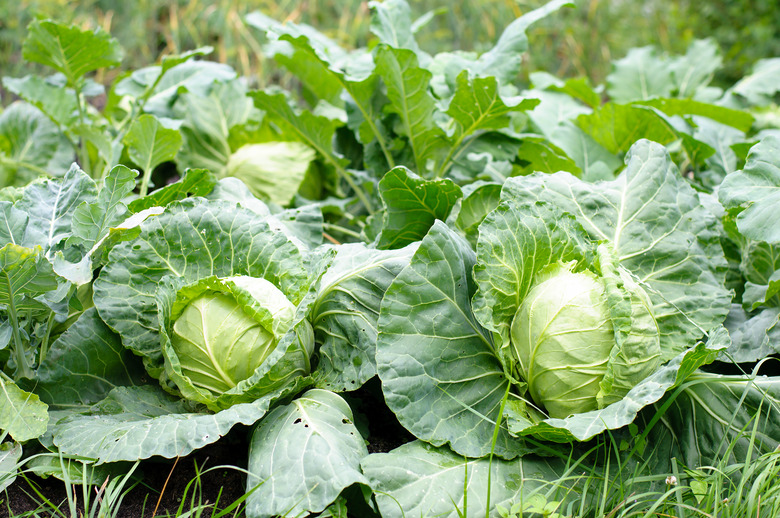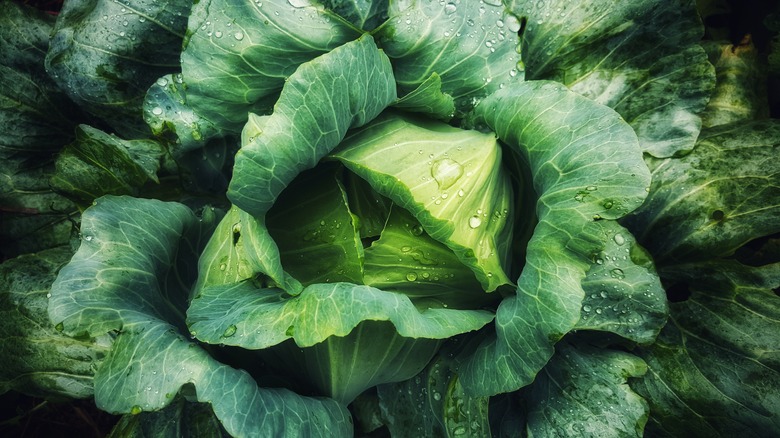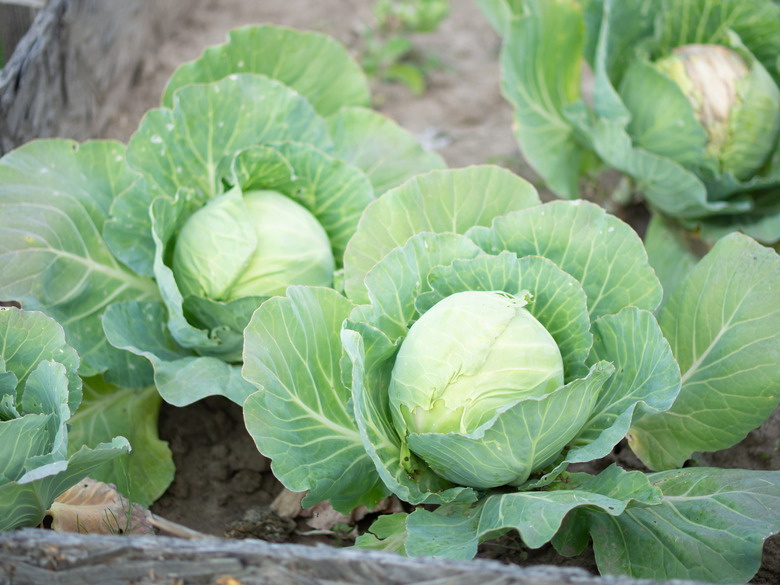How To Grow Cabbage
We may receive a commission on purchases made from links.
If you reserve a spot in your vegetable garden for growing cabbage (Brassica oleracea var. Capitata), you'll enjoy a vegetable with a interesting tidbit of history behind it. When Julius Caesar and his army invaded Britain in 55 B.C., they were armed with more than weapons — they also took cabbage with them, presumably to eat instead of hurling at the enemy. Historical significance aside, cabbage plants have been a food staple for many cultures through many generations.
As a cool-season biennial that's grown as an annual crop, cabbage plants produce edible leaves that grow into a rounded shape called a "head." Cabbage heads vary in size and color depending on the cultivar. If the smell of cabbage is off-putting, consider its nutritional benefits. Surprisingly, only 1/2 cup of cooked cabbage contains 25 milligrams of vitamin C, which is the same quantity as a medium tangerine.
Best Uses for Cabbage
Best Uses for Cabbage
Fresh, shredded cabbage leaves are the primary ingredient in coleslaw, one of cabbage's most common uses. Even though "cole" is a word of unknown origin to most people who enjoy this slaw, it's simply a reference to cabbage as one of the cole crops ("cole" from the Latin "caulis" for stem or stalk). Other cole crops are plants in the same genus and species as cabbage (Brassica oleracea), but they comprise different varieties in this group. For example, cauliflower (Brassica oleracea var. Botrytis) and kale (Brassica oleracea var. Acephala) are other cole crops that are different varieties of the same genus and species.
Cabbage is also commonly used in stir fry, and fermented cabbage leaves are the staple ingredient in sauerkraut and kimchi. Stuffed cabbage leaves and shredded cabbage added to soups are other ways to enjoy this vegetable.
Types of Cabbage You Can Grow
Types of Cabbage You Can Grow
There's not only diversity among the many ways cabbage can be prepared but also in the types of cabbage you can grow. Cabbage itself is a variety of Brassica oleracea, but within this variety are different cultivars (cultivated varieties).
Two popular green cabbage cultivars are 'Early Jersey Wakefield' and 'Copenhagen Market,' both of which are heirlooms that are ready to harvest less than 100 days after planting. Red cabbage cultivars include 'Red Head' and 'Ruby Ball Hybrid,' which take more than 100 days to mature after planting. Red cabbage has a slight peppery taste, and it adds a little zest in addition to color in salads, slaws and other raw preparations. However, if you cook red cabbage in vinegar or another acidic ingredient, it turns an unappetizing shade of bluish-gray.
Although most types of cabbage have smooth leaves, Savoy cabbage has crinkled leaves. Another characteristic of Savoy cabbage is its flavorful leaves. Perhaps Savoy cabbage's most desirable trait is that it does not have the pungent odor of other types of cabbage. Savoy cabbage cultivars include 'Savoy King,' 'Savoy Queen' and 'Savoy Ace.'
How to Grow Cabbage
How to Grow Cabbage
Starting Cabbage From Seed
As a rule of thumb, it's best to transplant seedlings in spring instead of sowing seeds directly in the garden because the cold soil may inhibit germination for direct-sown seeds. To sow cabbage seeds in the spring, start the seeds indoors six to eight weeks before the last frost date in your area and transplant the seedlings to the garden a couple of weeks before the last frost date. If you want to sow cabbage seeds directly in the garden, direct-seed them four weeks before the last spring frost date.
If you sow cabbage seeds in the fall, start the seeds indoors the first week in July and transplant seedlings to the garden six weeks later. If you want to sow cabbage seeds directly in the garden, direct-seed them the first couple of weeks in July.
When growing cabbage from seed whether you are starting indoors or directly sowing into the garden, sow the seeds 1/4 to 1/2 inch deep. If you start the seeds indoors, sow them in pots or seed-starting trays that contain a soilless seed starter mix. Keep the mix (or garden soil if seeds are direct-sown) moist but not soggy until the seeds germinate.
Starting Cabbage From a Seedling
Examine purchased seedlings; if they're older and already forming a head, they won't transplant well. When you transplant cabbage seedlings, make sure that you plant them only as deep as they were growing in their container because if you bury them too deeply, the stem may rot. Avoid planting cabbage in low-lying areas where the water doesn't drain well. Space young plants 12 to 18 inches apart within rows that are spaced 24 inches apart so that they'll have plenty of room for the head to grow.
In What Zone Does Cabbage Grow Best?
In What Zone Does Cabbage Grow Best?
With an affinity for cool weather, cabbage can be grown as an annual in USDA zones 2 through 11. Although it tolerates some frost, cabbage may be damaged by a hard freeze. Older plants are more resilient to cold temperatures than tender seedlings. Most mature cabbage plants can tolerate temperatures as low as 18 to 20 degrees Fahrenheit.
When Should You Plant Cabbage?
When Should You Plant Cabbage?
When deciding whether to plant cabbage in early spring for a summer harvest or in late summer for a fall harvest, consider the growing season and weather conditions for this cool-weather crop. If you plant cabbage too late in the spring, the hot temperatures of summer will hinder its ability to mature properly and to stave off insect and disease pressure. If you plant cabbage too late in the fall, the freezing temperatures of winter may spoil your crop before it matures. Use the guidelines for starting cabbage from seeds or seedlings to tailor your planting times.
Soil, Sunlight, and Water Recommendations
Soil, Sunlight, and Water Recommendations
Grow cabbage on loose, fertile soil for best results. If the soil in your garden is heavy, such as hard clay, incorporate compost or other organic matter with a spade or rototiller to a depth of at least 6 inches. You can also grow cabbage in a raised bed, which provides another cultural must-have: good drainage. An optimal soil pH falls in the range of 6.0 to 6.8.
Cabbage needs full sun for healthy growth — at least six to eight hours each day — and even though it tolerates partial shade, cabbage tends to get leggy at the expense of developing full heads without lots of sun.
Give cabbage plants 1 inch of water each week if there's insufficient rainfall. Because these plants are shallow-rooted, apply 3 to 4 inches of mulch around plants to help keep the soil cool and moist.
Avoid fertilizers with excessive nitrogen; instead, apply a starter fertilizer with a higher phosphorus-to-nitrogen ratio (15-30-15, 16-32-16 or an organic equivalent) when planting cabbage. Only apply this fertilizer if a soil test warrants the need for phosphorus.
How to Harvest Cabbage
How to Harvest Cabbage
Different cabbage cultivars have varying maturity times, with harvest windows generally falling within 60 to 80 days after transplanting in the garden. Check the number of days before harvest for your specific cultivar to put a good ballpark date on your calendar. As soon as the heads are firm and tightly filled and not spongy or soft, it's time to harvest them.
Harvesting cabbage is easy. With a sharp knife, cut the head just above the area where the outer leaves are joined to the stem. Don't let cut cabbage linger in the sun because it can actually lose weight and blister. Cold storage in the refrigerator or even colder storage in a root cellar helps keep cabbage firm and fresh. At 34 degrees and 98 percent humidity, cabbage will stay fresh for up to five months.
Common Pests and Other Problems
Common Pests and Other Problems
Primary insect pests of cabbage include cabbage webworms, cabbage loopers, cabbage maggots and aphids. Aphids pierce cabbage leaves and feed on the plant sap, which causes leaves to cup and curl. In a worst-case scenario, an aphid infestation can kill cabbage plants. Early detection and control is the best remedy for aphids. You can dislodge insects from your plants by directing a stream of water from your garden hose, or you can spray plants with insecticidal soap.
Different species of cabbage worms and cabbage loopers are the larval (caterpillars) stage of moths. These sometimes persistent pests eat holes in cabbage leaves and weaken plants with their feeding. If you don't have an infestation of caterpillars, simply hand-pick these pests. You can also control them by using Bacillus thuringiensis (Bt), which is the active ingredient in many brand-name products, and even though Bt is an organic control, be sure to follow all label recommendations.
Cabbage maggots are the larval stage of a fly. Flies lay their eggs at the base of cabbage plants where the stem meets the ground. When the larvae hatch, they burrow into the soil and feed on cabbage roots.
Early in the growing season when moths and flies lay eggs on cabbage plants that hatch into destructive caterpillars and maggots, covering cabbage plants with a floating row cover can help protect them from these pests.
If you wait too long to harvest cabbage, the heads will split, and the flavor diminishes. Head splitting, also called head cracking, can also occur when the cabbage is close to maturing, and there are periods of heavy rain or excessive irrigation, particularly after a period of drought. The heads grow so fast in response to the water that they crack. Look for a cultivar that is resistant to cracking if you live in an area with sporadic or inconsistent rainfall.
Common Diseases
Common Diseases
Black rot is the disease that typically causes the most serious damage on cabbage, typically occurring during warm, moist weather. This bacterial disease (Xanthomonas campestris pv. campestris) is transmitted through infected cabbage seeds or transplants, and the telltale symptom of black rot is the presence of dark V-shaped lesions on the leaves. If your cabbage plants have black rot disease, there is no cure, and you'll have to remove the plants from your garden.
When you buy cabbage transplants, look for an attached tag that certifies they are disease-free. At the end of each growing season, be sure to remove all plant debris, which can harbor disease pathogens over winter and reinfect the following year's crops. Practicing crop rotation can also help prevent disease. Avoid planting cabbage or any other type of cole crop in the same garden spot for at least three to five years.


